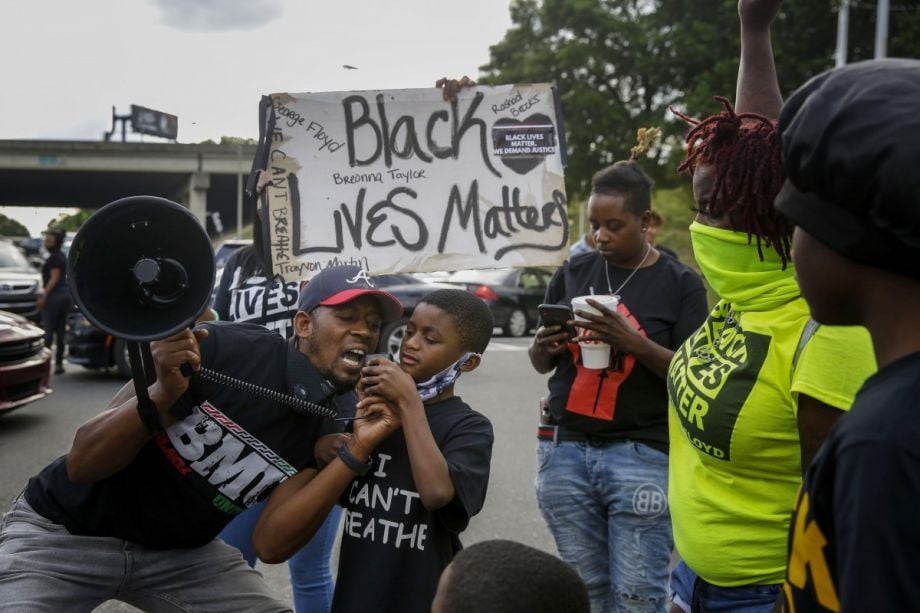The same year the towering Mercedes-Benz Stadium opened in Atlanta’s Vine City neighborhood, homeowners moved into five green, blue and beige homes less than a mile away. These homes were meant to be part of something bigger: a plan to improve police-community relations by encouraging police to live within the city of Atlanta, instead of the suburbs. But four years after officers began living in them, with a growing appetite for solutions to reshaping policing, questions remain about how well this program has worked at a critical juncture. In Part 1 of this two-part series, we explored whether community-police relations have improved; while some program architects and an officer say living in Vine City has had its benefits, residents tend to disagree. In this second part, we explore these questions further. If you haven’t read Part 1, you can do so here.
One of the key ideas of the Secure Neighborhoods program is that housing police among the people discourages crime. But even homes owned by Atlanta police officers do not always create a deterrent.
One officer’s home in English Avenue, a neighborhood next to Vine City, was firebombed in 2019. Later that year, a group of men opened fire at an apartment complex around the corner from an officer-owned house in Vine City. Police investigated a double shooting in July at a home on Brawley Drive, a half mile down the same street as the five officer-owned homes.
The officer housing, which is run by the Atlanta Police Foundation, has also led to concerns of gentrification. It’s a persistent worry in not only Vine City but English Avenue and the nearby neighborhood of Pittsburgh.
Atlanta homes in the program were sold at cost to officers for an average of $250,000, says Dave Wilkinson, president and CEO of the Atlanta Police Foundation. In addition, the police foundation provides an average of $60,000 as a form of down payment assistance. Officers must pay that back if they don’t stay in their home for five years.
In order to make sure officers are invested in the community, they are required to make the house their primary residence and aren’t allowed to own a second home, Wilkinson says.
Initially, all the houses were meant for officers, but after residents raised affordability concerns, five of the houses went to legacy residents of the neighborhood.
Vine City resident Pam Flores, who was part of initial discussions about the program, says that isn’t enough. She suggests that for every house built for an officer, there should be a house for a resident too. Meanwhile, the houses valued at $250,000 contribute to rising property values in Vine City, she says.
“How welcoming do you think the indigenous population is when they’re seeing all the new shiny stuff go up, and they’re watching new neighbors move in, and then they’re excluded from those opportunities?” Flores says.
LaTeef Pyles, a community barber who has lived in Vine City for 15 years and who initially advocated for officers to live in the neighborhood, wondered who the police housing program makes Vine City more appealing for: existing residents, people looking to move in or investors.
“[The police foundation and Blank Family Foundation are] definitely gentrifiers to a degree because they want to see change out here—and they and the corporations have the funding to make change,” Pyles says. “What type of activity is going on in the community where they feel like you have to force police officers to be here?”
Michael Leo Owens, associate political science professor studying policing at Emory University, says any program designed and implemented by outside organizations has the potential to produce problems or not be fully accepted.
Making places safer is also associated with gentrification, Owens says. Everyone wants to feel safe where they live, but in the absence of anti-displacement measures, crime reduction can create more favorable conditions for new residents and investors. That’s the makings of gentrification.
“On the one hand, the police are there to provide public safety in a general sense and in a particular sense for whoever lives there now. But we also can think about the police being utilized as a force for gentrification,” Owens says. “We certainly know that crime is one of those factors that affects where money flows or doesn’t flow.”
Ultimately, most residents interviewed by Next City didn’t feel more trust toward police because of the program. Colette Haywood, a community advocate living in Vine City, says she has more confidence in individual officers than before, but not in the institution of policing. Her son-in-law is an Atlanta police detective.
Just like anywhere, Vine City’s residents have differing attitudes toward police. Owens says the police are hearing from a particular set of voices in Atlanta’s neighborhoods: People in neighborhood associations and Neighborhood Planning Units (NPU), citizen advisory councils that are in every Atlanta community. Generally, the NPU system reflects the interests of propertied residents who are either professional or retired and therefore have the time to devote to planning matters. Owens says this group of people, which don’t necessarily represent the majority of residents who don’t attend neighborhood meetings, are likely to be pro-police.
Officers in the program are required to go to their local NPU meetings.
In summer 2020, Black Lives Matter protests provided a stress test for the housing program. Protests started in the city’s iconic Centennial Olympic Park, only a few blocks from the police houses on Brawley Drive. As broken windows at the CNN Center and police cars in flames drew national attention, Mayor Keisha Lance Bottoms put out a desperate, televised plea for demonstrators to go home.
Less than two weeks later, Rayshard Brooks was killed by Officer Garrett Rolfe.
With officers living in their community, did Vine City residents feel closer to police during this time?
Residents interviewed didn’t see a difference. Flores, who had wanted more officers in Vine City, thought about them during the protests but didn’t speak with them. When she walked or biked around the neighborhood, Flores heard people’s “vengeance and upset” about the police and wondered how the officers in Vine City felt.
“But because we’re not that friendly neighbors, I’m not going to go and check on a cop for obvious reasons,” she says.
Owens says the program doesn’t affect the systemic issues of police violence that sparked the BLM protests and the ensuing discussions on policing. Knowing an individual officer doesn’t mean people know what that officer does on the job or speak to the institution of policing, he says.
“Putting officers in houses in no way can have an effect on how do communities get to keep, if they’re able, police accountable to civilians,” Owens says.
The Secure Neighborhoods program, which didn’t undergo any changes due to the protests, is continuing to grow. Wilkinson, of the Atlanta Police Foundation, projects that at least 10 police homes will be built each year, eventually expanding to Atlanta’s southeast and northwest sides.
He says the Atlanta City Council is looking for land for more officer housing. After a failed bid for the city council to temporarily withhold $73 million of the police department’s 2021 budget, the council this year increased the 2022 police budget by 7%. It now accounts for nearly one-third of Atlanta’s budget, making it the most well-funded department in the city.
Wilkinson believes that the officer housing program continues to be important as many in Atlanta worry about a spike in violent crime. Having police officers as representatives in the community helps people get to know them on an individual level, he says.
Still, the police housing program has left some of these residents unhappy.
“I really wish that they would have been more intentional about the end result,” Flores says of the program, “not just meet the mark of moving X amount of cops into a neighborhood.”
This article is part of Backyard, a newsletter exploring scalable solutions to make housing fairer, more affordable and more environmentally sustainable. Subscribe to our weekly Backyard newsletter.

Adina Solomon is a freelance journalist based in Atlanta. She writes on a range of topics with specialties in city design, business and death. Her work has appeared in The Washington Post, CityLab, U.S. News & World Report, and other national and local outlets.










